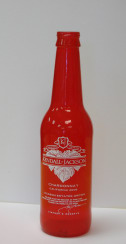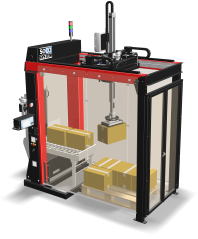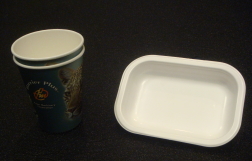CHANGE THE COLOR OF YOUR GLASS CONTAINER IN 15 SECONDS
VIDEO DIAGNOSTICS: WORTH WATCHING
ARE PNEUMATICS LOSING AIR?
PALLETIZER MEASURES CASES, SUGGESTS PATTERNS
SUSTAINABLE TECHNOLOGY REDUCES COST, WEIGHT AND BREAKABILITY OF PLASTICS
RIGHT OR LEFT? HOW ABOUT BOTH?
ENDLESS POSSIBILITIES WITH POUCH MACHINE
SOMETHING ‘NEW’ IS MISSING AT THE SHOW
PLA INTERESTS FRITO-LAY, BUT PROBLEMS LOOM
Frito-Laywants to put its snacks in compostable/biodegradable flexible bags, but is still far from finding a completely compostable bag that will provide adequate product protection, a top packaging executive told attendees at a Pack Expo conference on Tuesday.Jay Gehring, vice president of technology for PepsiCo’s Frito-Lay unit, gave a talk entitled “Creating a Better Tomorrow than Today.” He highlighted Frito-Lay’s environmental efforts in areas including energy, water usage and packaging.
Frito-Lay has reduced its total packaging usage by 10% over the last five years, Gehring said, but added, “The reduce agenda can take you only so far.” The ultimate goal is to come up with flexible film that is made completely from renewable resources and is biodegradable in any environment.
Packaging is a highly visible source of pollution that can be easily traced to the company that uses it, Gehring said: “If you’re walking in a park or on a beach, it’s an embarrassing fact that you’re likely to see a Frito-Lay bag somewhere it doesn’t belong.”
The company has experimented with, and in fact has commercialized, snack bags whose outer, reverse-print layer is made from corn-derived polylactic acid (PLA) film. About 50 million such bags have been produced, Gehring said.
The problem lies in using PLA or similar material in the inner layer, which provides moisture and oxygen barrier, and the middle layer, which holds the film together. PLA as currently constituted is unsuitable because it attracts moisture, Gehring says: “We have to figure out how to put barrier properties on a sponge.” He estimated that an all-PLA bag would reduce the shelf life of Frito-Lay snacks by 90%.
Pan Demetrakakes, Executive Editor, Food & Beverage Packaging

Hartness
CHANGE THE COLOR OF YOUR GLASS CONTAINER IN 15 SECONDS
Hartness InternationalBooth #N-4129; 262-835-1673
Nope. That’s not a misprint. Hartness Inks has launched Uvaclear, a bottle coating technology that adds smooth, consistent color--anycolor in the Pantone range--to the outside of flint glass bottles using spray coating expertise fromNordsonand ultraviolet-curable inks fromInx.
The color-coated containers can be further decorated with direct printing or labels (glue-applied, pressure-sensitive or shrink-sleeve).
Noteworthy sustainability benefits include:
--Energy savings from the 15-second changeover (typically, it takes about eight days for glass manufacturers to complete a color change before getting back to production mode).
--No need for pre-sorting in glass recycling facilities (currently recyclers have to sort different colors). This color coating doesn’t impact the recycling process, so bottles don’t need to be sorted.
The 13-micron film coating provides UV barrier, and Hartness is working to develop a clear coating. Bye-bye amber beer bottles!
Lisa McTigue Pierce, Editor-in-Chief, Food & Beverage Packaging
VIDEO DIAGNOSTICS: WORTH WATCHING
A trend I’ve been tracking is the use of video technology for machinery troubleshooting. Our Machinery Matters columnist John Henry will write about this in more detail in an upcoming column. But here are some companies touting this at Pack Expo:--Oystar Jones (Booth #S-830; 859-341-0400)
--Polypack (Booth #S-1526; 727-578-5000)
--Hartness Int'l (www.hartness.com) (Booth #N-4129; 262-835-1673)
--ProSoft (Booth #E-6853; 661-716-5268)
--Marlen (Booth #N-4510; 913-888-3333)
If you stop by any of the companies mentioned in this newsletter, please tell them you read about them in the eDaily News at Pack Expo report. Thank you!
Lisa McTigue Pierce, Editor-in-Chief, Food & Beverage Packaging
ARE PNEUMATICS LOSING AIR?
Several manufacturers have designed machinery so they could replace pneumatics:--Kliklok’s Apache bag maker (Booth #S-1601; 770-981-5200)
--Diagraph’s Platinum E-Series print-and-apply labeler (Booth #S-1912; 800-722-1125)
--Oystar Packaging Technologies’ FP Series container filling/sealing system (Booth #S-830; 563-391-1100)
The reasons for the switch away from pneumatics vary, but reliable performance and energy loss during conversion are two that I heard. When asked about whether this trend might continue, engineers fromFrito-LayandP&Gsaid the cost benefit for pneumatics is still pretty strong.
The gauntlet is down, though, for engineers to keep pneumatic technology viable and vibrant for motion control. Some have already risen to the challenge.
Bossar USA (Booth S-1276; 941-351-3023) uses pneumatic cylinders as a retrofit kit for its BMK line of horizontal pouch form-fill-seal systems to produceretortpouches. A meter on the pneumatic cylinder allows users to adjust, measure and control dwell times and apply up 3,000 pounds of pressure on each sealing bar to guarantee seal integrity, which is critical for retort applications.
Lisa McTigue Pierce, Editor-in-Chief, Food & Beverage Packaging

Soco System
PALLETIZER MEASURES CASES, SUGGESTS PATTERNS
Soco SystemBooth #S-2187; 011-45-43-52-55-66
A modular palletizer automatically measures cases and suggests pallet patterns to the operator based on the case dimensions.
“Robot in a Box” from Soco System is a self-contained, modular palletizer with a gantry-style robot and adjustable infeed conveyor. The robot’s end-of-arm tooling includes a laser probe. When an operator activates the self-programming wizard on the system’s controller, the robot arm slides around the box and the probe measures it. The controller then suggests several possible pallet patterns, giving the number of cases that each pattern will allow on the pallet.
“Robot in a Box” was introduced at the Interpack show in Germany in May. Pack Expo marks its U.S. debut.
Pan Demetrakakes, Executive Editor, Food & Beverage Packaging

MicroGreen
SUSTAINABLE TECHNOLOGY REDUCES COST, WEIGHT AND BREAKABILITY OF PLASTICS
Editor’s note: Although this company is not an exhibitor, its representatives meet with us at the show to discuss its new technology.MicroGreen Polymershas introduced its new innovation in sustainable polymers for food and beverage packaging that expands solid-state polymers with billions of microscopic cells in its structure. This technology reduces weight, increases end-product functionality and allows for more plastic to be developed from less resources.
“To my knowledge, there is no product like this on the market,” says Tom Malone, CEO of MicroGreen Polymers. “However, there definitely needs to be one.”
Two end-product examples for food and beverage companies were used to demonstrate the technology: a thermoformed plastic tray and an rPET overwrap for a conventional paper cup to display stronger graphics capability.
“It’s not like a plastic, but it’s not like a paper, either,” says Malone.
Moving from the rPET overwrap, Malone says MicroGreen is in the process of developing the first non-paper insulated cup with the technology.
Randy Hofbauer, Associate Editor, Food & Beverage Packaging
RIGHT OR LEFT? HOW ABOUT BOTH?
Wexxar Packaging, A ProMach Co.Booth #S-2308; 604-930-9300
Here’s a first: One small-footprint machine is now able to erect cases of right- or left-hand orientation. The Wexxar WF10 mechanical case erector uses Pin & Dome technology for safe and ergonomic operation. All moving parts of the Pin & Dome have been kept down low and within the machine frame for added safety but without the need for a lot of elaborate and costly guarding.
Changeover from left to right and vice versa is done within 15 minutes. All changeover points are on both sides of the machine, and the operator interface can be positioned on either side. Suitable for any operation that receives cases from several suppliers or in both orientations (such as contract packagers). Speed is 10 cases per minute.
Lisa McTigue Pierce, Editor-in-Chief, Food & Beverage Packaging
ENDLESS POSSIBILITIES WITH POUCH MACHINE
Karlville Development LLCBooth #E-7147; 305-533-1051
“What machine can put me into business today?” posits Jim Pease, director of Karlville Development’s pouch and filling division. The answer: Karlville’s KSG multi-format pouch machine, which produces 2- and 3-side seal bags, stand-up pouches, side-gusset bags and center-seal bags, putting any converter in any business virtually in an instant. Where a converter was once required to house as many machines as bags it was required to produce, Karlville’s affordable product changes the game and lets sales drive production, making the machine an excellent match for converters seeking to enter markets and remain flexible enough to pursue growing and changing markets.
Available in 600 and 800 millimeter widths, the machine can produce pouches PE/PE, PECOEX monolayer and multilayer PET, foil, paper or nylon pouches between 50 and 600 mm wide and 50 to 600 mm long. The machine can also be modified to integrate cross web or longitudinal closure systems, like sliders, press-to-close zippers or pre-applied Inno-Lok closures.
Sayre Kos, Associate Editor, Flexible Packaging
SOMETHING 'NEW' IS MISSING AT THE SHOW
Take a look at our eDaily News at Pack Expo reports and you’ll see that there’s plenty of new products and technologies at the show. But what’s missing in many booths that have news to tell is a sign with the word “New!” on it. Did we run out of placards and ink? Or decide not to spend the extra money in this challenging economy? This simple, three-letter word is a magnet to draw attendees (and editors!) into booths. Note to exhibitors: Use it, please!Lisa McTigue Pierce, Editor-in-Chief, Food & Beverage Packaging
